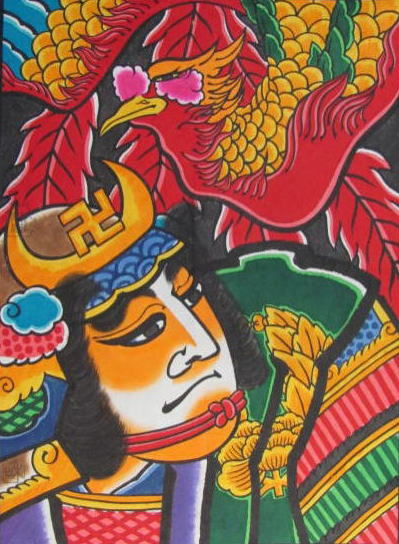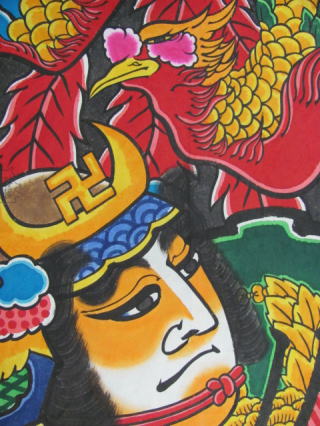¥12,000
サイズ 西の内2枚版
■商品コード T-16005■
・二代信枚公と朱雀 (小)
¥6,000
サイズ 西の内1枚版
■商品コード T-16006■
▶注文(メール)
and the White Tiger
(large) ¥12,000
Size: Nishi-Nouchi 2-page
edition
Product code T-16003
・Princess Manten
and the White Tiger
(small) ¥6,000
Size: Nishi-Nouchi 1-page
edition
Product code T-16004
▶email order
- 価格は、「本体価格」表記です。別途、消費税が加算されます。
- これらの津軽凧絵は、絵のみとなります。
(骨組みを有する凧ではありません。)
注文制作となりますので、繁忙期の有無によりますが、数か月かかる場合がございますので、お尋ねください。 - 額入の場合、額の種類等により価格が異なりますので、ご相談ください。
- サイズは、西の内の尺度となります。
西の内1枚(333mm×485mm)は、半紙(243mm×333mm)2枚。
- All prices are listed in the table below. A separate consumption tax will be added.
- These Tsugaru kite paintings are paintings only.
(It's not a kite with a frame.) - It may take several months depending on the busy season, so please contact us.
- The price of a framed picture differs depending on the type of the frame, so please consult with us.
- The size will be on a scale of Nishinouti (west inside).
One sheet (333mm x 485mm) of Nishinouti (west inside) is two sheets of half-paper (243mm x 333mm).


- 津軽信枚(つがる のぶひら、信牧とも書く)は、陸奥弘前藩2代藩主。津軽為信の三男。母は側室の栄源院。正室は徳川家康の養女・満天姫(松平康元の娘)。側室に高台院の養女・辰姫(石田三成の娘)。
- 慶長元年(1596年)、父の命により兄の津軽信建・信堅とともにキリスト教徒となっていた。慶長5年(1600年)、関ヶ原の戦いの折、親子兄弟が分かれて東西陣営両天秤にかけたとも言われている。嫡男の信建が豊臣方に在し、石田三成の遺児である石田重成を匿ったことが確認される津軽氏だが、ある関ヶ原合戦図の東軍家康本陣には「卍」の旗が書かれている。これが津軽信枚が家康本陣に詰めていたとされる一史料である。
- 戦後数々の親石田・西軍方的な動きなどが不問となり、津軽一族で父・為信、兄・信建を差し置いて、ひとり信枚だけが論功叙任されていること、わずかながらも上野国大館に加増2,000石を受けていることなどから、前述の説が真実味を増す。
- 慶長12年(1607年)、兄の信建・父の為信の相次ぐ死により信枚が家督を継承した。家督相続のお礼言上に江戸へ伺候した際、天海僧正に弟子入りする。天台宗に帰依改宗して教義を学び、藩内に天台宗寺院を建立して天海の高弟を迎え布教に尽力した。津軽藩の江戸藩邸は、天海のいる上野寛永寺そばに設けられ、後に津軽家の菩提寺津梁院となる。
- 慶長13年(1608年)、兄・信建(父・為信より先に夭逝)の遺児・熊千代(大熊)を擁する家中一派との、家督を巡る争いが起こる。一時津軽氏は取り潰しの危機にさらされたが、信枚は幕府に対して親睦策を取り、幕府人脈および幕閣の対立を背景にしてこの争いに勝利し、改易の危機を免れたという。その後津軽建広ら熊千代派閥の粛清を行った(津軽騒動)。
- 慶長14年(1609年)には先代より整備が始まっていた高岡城(のち弘前城と城名が変わる)築城の正式許可が下りる。これを受け、5万石に満たない大名としては破格の五層の大天守をも持つ城郭を、着工から1年2ヶ月という早さで慶長16年(1611年)構築し、城下に現在の弘前市に繋がる城下町を整備した。「幕府は北辺警備の都合も考慮して、大城郭築城を許可した」とも言われている。また天海の推挽により慶長18年(1613年)、徳川家康の養女・満天姫(再嫁。前夫は福島正則養子の福島正之)を妻に迎えたことも、江戸幕府体制下での津軽氏の地位を固めた。 信枚にはそれ以前に辰姫を正室としていたが、満天姫を迎えるにあたり正室から側室に降格させている。
- この辰姫は豊臣秀吉正室の高台院の養女という身分であったが、実父は石田三成であり、幕府を憚った措置であるとも、幕府側から津軽家の態度を試す措置であったとも受け取れる。その後、江戸でも国許でもない前述の上野国の飛び領地に住んだ辰姫は大舘御前と称され、信枚は参勤交代の度に訪ね、二人の仲は変わらず睦まじかったと伝わっている。辰姫は、元和5年(1619年)に信枚の長男信義を生み、数年後死亡した。信義誕生の翌年には満天姫にも男児(信英)が生まれている。
- 慶長19年(1614年)、大坂冬の陣に徳川方として兵を率いて参陣したが、家康は信枚に江戸勤番を命じた。後に弘前藩が編纂した『津軽一統志』では「津軽は北狄の圧(おさえ)(略)要服の地たるにより(略)在国を憑(たの)むところなり、早速帰国に及ぶべし」と帰国を命じられたことにされている。
- Tsugaru Nobuhira (also known as Nobumaki) was the second feudal lord of the Mutsu Hirosaki clan.
He is the third son of Tsugaru Tamenobu.
His mother is Eigenin, the side chamber.
She is the adopted daughter of Tokugawa Ieyasu, Princess Mitsuten (daughter of Matsudaira Yasumoto).
The adopted daughter of Koudaiin, Tatsuhime (daughter of Ishida Mitsunari), is in the side room. - In 1596, by his father's order, he became a Christian along with his older brothers, Tsugaru Nobutake and Nobukata.
It is said that in 1600, during the Battle of Sekigahara, the father and siblings were separated and placed on the eastern and western sides of the battlefield in the 5th year of Keicho (1600).
It is confirmed that his son, Nobutake, was on the side of Toyotomi and sheltered Ishida Shigenari, the bereaved son of Ishida Mitsunari, in the Tsugaru clan.
This is a document that Tsugaru Nobuhira is said to have packed in Ieyasu's main battlefield. - In the Tsugaru clan, only one Nobuhira was appointed as a meritorious leader, leaving behind his father, Tamenobu, and his brother, Nobutake, and the fact that many pro-Ishida and western military movements were dismissed after the war.
The aforementioned theory is reinforced by the fact that he received an additional 2,000 koku from Odate in Kouzukenokuni, although only slightly so. - In 1607 (Keicho 12), Nobuhaira succeeded to the viceroyalty due to the successive deaths of his brother Nobutake and father Tamenobu.
On the occasion of a visit to Edo (Tokyo) to thank for the inheritance of his family, he became a disciple of Tenkai Priestess.
He converted to the Tendai sect and learned its doctrines, built a temple of the Tendai sect within the clan, and welcomed a high-ranking brother of Tenkai and devoted himself to missionary work.
The Tsugaru clan's Edo domain residence was set up near Ueno Kan'ei-ji Temple, where Tenkai is located, and later became Tsuryoin, the family temple of the Tsugaru family. - In 1608 (13th year of Keicho), a battle for the viceroyalty of the family takes place between the clan with Kumachiyo (Okuma), the deceased son of his brother Nobutake (who died prematurely before his father Tamenobu).
The Tsugaru clan was in danger of being destroyed for a time, but Nobuhira took friendly measures against the shogunate and won the conflict with the shogunate's personal connections and the shogun's cabinet, thus avoiding the danger of a change of government.
Later, he purged the Kumachiyo faction, including Tsugaru Takehiro (Tsugaru Riot). - In 1609 (Keicho 14), official permission was granted to build Takaoka Castle (later renamed Hirosaki Castle), which had been under construction since the previous generation.
In 1611 (Keicho 16th year), he built a castle enclosure with a five-tiered keep, which was uncommon for a feudal lord of less than 50,000 stone, and built a castle town underneath the castle that connects to present-day Hirosaki City.
It is also said that "the shogunate gave permission for the construction of a large fortress, taking into account the convenience of the northern security.
He was also adopted by Tokugawa Ieyasu in 1613 (Keicho 18) as Princess Manten (remarried). The Tsugaru clan's position under the Edo shogunate was also solidified when the former husband adopted Fukushima Masayuki (Fukushima Masanori's adopted son) as his wife.
Nobuhaira had Tatsunhime as his wife before that, but when he welcomed Mantenhime, he demoted her from a wife to a side wife. - Although Tatsunhime was the adopted daughter of Kodaiin, the wife of Toyotomi Hideyoshi's wife, her real father was Ishida Mitsunari, it could be taken as a measure to test the attitude of the Tsugaru family from the shogunate's side.
Later, Tatsunohime, who lived in the aforementioned land in Kozuke, neither in Edo nor under a national license, was called Odate Gozen, and Nobuhira visited her every time she went to work, and it is said that the two were as close as ever.
Tatsunhime gave birth to Nobuhira's eldest son Nobuyoshi in the 5th year of Genwa (1619), who died a few years later.
The year after Nobuyoshi's birth, Princess Manten also had a baby boy ( Nobuhide). - In 1614, Ieyasu ordered Nobuhira to take charge of the Edo battle.
According to the "History of Tsugaru" compiled by the Hirosaki clan, Tsugaru was ordered to return to their homeland as soon as possible.